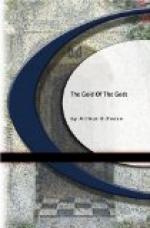“You know the jimson weed—the Jamestown weed, as it is so often called?” he continued, explaining. “It grows almost everywhere in the world, but most thrivingly in the tropics. All the poisons that I have mentioned are related to it in some way, I believe.”
“I’ve seen the thing in lots and fields,” I replied, “but I never thought it was of much importance.”
“Well,” he resumed, “the jimson weed on the Pacific coast, in some parts of the Andes, has large white flowers which exhale a faint, repulsive odour. It is a harmless-looking plant, with its thick tangle of leaves, a coarse green growth, with trumpet-shaped flowers. But to one who knows its properties it is quite too dangerously convenient for safety.”
“But what has that to do with the evil eye?” I asked.
“Nothing; but it has much to do with the cigarettes that Whitney is smoking,” he went on positively. “Those cigarettes have been doped!”
“Doped?” I interrogated, in surprise. “With this weed of madness, as you call it?”
“No, it isn’t toloache that was used,” he corrected. “I think it must be some particularly virulent variety of the jimson weed that was used, though that same weed in Mexico is, I am sure, what there they call toloache. Perhaps its virulence in this case lies in the method of concentration in preparing it. For instance, the seeds of the stramonium, which is the same thing, contain a much higher percentage of poison than the leaves and flowers. Perhaps the seeds were used. I can’t say. But, then, that isn’t at all necessary. It is the fact of its use that concerns us most now.”
He took a drop of the liquid which he had isolated and added a drop of nitric acid. Then he evaporated it by gentle heat and it left a residue slightly yellow.
Next he took from the shelf over his table a bottle marked “Alcoholic Solution—Potassium Hydrate.” He opened it and let a drop fall on the place where the liquid had evaporated.
Instantly the residue became a beautiful purple, turning rapidly to violet, then to dark red, and, finally, it disappeared altogether.
“Stramonium, all right,” he nodded, with satisfaction at the achievement of his night’s labours. “That was known as Vitali’s test. Yes, there was stramonium in those cigarettes—datura stramonium—perhaps a trace of hyoscyamine.”
I tried to look wise, but all I could think of was that, whatever his science showed me now, my instinct had been enough to prompt me not to smoke those cigarettes, though, of course, only Kennedy’s science could tell what it was that caused that instinctive aversion.
“They are all like atropine, mydriatic alkaloids,” he proceeded, “so called from the effect they have on the eye. Why, one-one hundred thousandth of a grain will affect the eye of a cat. You saw how it acted on our subject. It is more active in that way than atropine. Better yet, you remember how Whitney’s eyes looked, how Inez said her father stared, and how she feared for Lockwood?”




